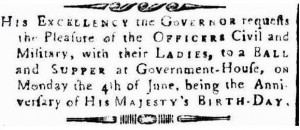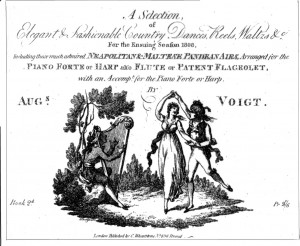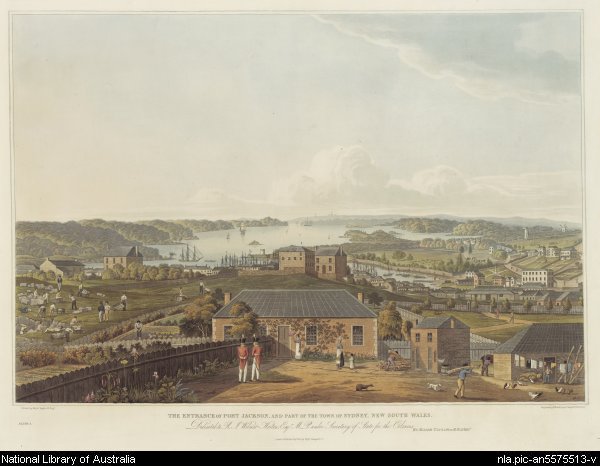
By the time the first Sydney Gazette was printed in 1803, official Government balls were well established.
The early colonial era in Australia is recognised as one of the best documented histories of an emerging nation, this however, does not extend into the area of dance. Research of dances in the first half of the colonial period has been limited due to the extreme difficulty in finding pertinent records. It has been assumed that as dancing was not mentioned it did not exist, yet quite the opposite is true – dancing was a daily occurrence which people felt no need to record.
Both convicts and the small elite immediately established traditional pastimes which had at their core the notion of pleasure and entertainment for its own sake, for enjoyment.
The Rocks. Life in Early Sydney. Grace Karsken. Melbourne University Press, 1997.
Dance was a fundamental element of everyday social life in the colony and many references to dancing in the earliest days of settlement exist. At all levels of society, dancing provided the opportunity to maintain civilisation far from their native shores, preserving culture and heritage, and above all establishing a sense of community. For the better classes, dance was an expression of education and gentility; for the lower classes, an opportunity to gather and carouse. It was noted in Commissioner Bigge’s report [1823] on the colony that dance was the chief entertainment for the lower orders, as evidenced by the proliferation of dance halls. Amongst the earliest music composed in Australia was a suite of quadrilles, testimony to the importance of this recreation in the infant colony:
Mr Reichenberg, Music Master, of the 40th Regiment, respectfully informs the Ladies and Gentlemen of the Colony, that he has composed a first Set of Quadrilles for Australia, with proper figures adapted to it, for the Pianoforte, Flute or Violin; as also, for a full Band. The Same may be had in manuscript, from Mr Reichenberg, at the Military Barracks; or at Mr. Campbell’s, No. 93, George Street, by giving one Day’s Notice. Price 6s.
The Sydney Gazette, 28th April. 1825.
Modern historians such as Grace Karsken and James Boyce, have provided fascinating insights into the society of the lower orders which have completely overthrown old conceptions of life in the colony and confirmed that dance was a regular daily activity. Just as the French danced through the Revolution to forget the austerity and terror, so the convicts sought diversion from the starkness of their situation with music and dance. The majority of convicts were not imprisoned and chained but rather enjoyed a much more unfettered life than generally imagined, they were free to gather, drink, gamble, fight, wed, celebrate, perform plays, make music, sing, and dance.
As the settlement spread, isolation became a factor bringing an even greater significance to dances, sometimes providing the only opportunity for people to socialise and young ones to meet – celebrations would commonly last for three days.
The Dances

A Selection of Elegant & Fashionable Country Dances, Reels, Waltzes & c. for the Ensuring Season 1808.
Wheatstone Manual, National Library of Australia.
Forms of dance in the first thirty years of settlement included the English country dance, the minuet, reels, cotillions, hornpipes, jigs, and later, quadrilles and waltzes. These dances were the popular culture of the western world – The British Isles, Europe, America, Australia – and although performed differently from place to place and from event to event, the dances remained essentially the same. Although there is no doubt regarding the types of dances, the problem in Australia becomes the lack of detail regarding specific dances. Dance is by nature ephemeral, and although many newspapers and diaries recorded marvellous dances and balls featuring country dances and reels, and lasting until dawn, virtually no one mentions the title of a dance.
Dance programmes did not exist and the honour of selecting dances fell to the top couple (especially the lady) who must describe and demonstrate the figures, steps and phrasing to the music. Some dances were popular or traditional varieties which everyone knew, some came from collections of the latest dances and others were devised on the spot.
Dance titles often reflected current events of the time and could be named in honour of famous and influential people: Lord Sydney’s Fancy, Lord Howe’s Jig ; to commemorate special events: The Transit of Venus; in memory of places: Braes of Breadalbane. This is most helpful in the search for dances relevant to Australian history – the dance Botany Bay, published in 1788, was composed to mark the establishment of the new colony on the other side of the world.

Original music and dance instructions for Botany Bay, 1788. Courtesy of Kate Van Winkle Keller
The scarcity of information regarding specific dances has necessitated a more thoughtful and academic approach with dances being selected using British sources of the period, where it can be demonstrated that there is a significant historical link to Australia. I have attempted to utilise every possible aspect of historical research available: not only the considerable resources in Australian libraries but also museums, art galleries and historic houses. This has revealed such treasures as Anna King’s ball gown [1805], Elizabeth Macquarie’s cello [1814], and Captain Piper’s domed ballroom in the shape of St Andrew’s cross [1820], the earliest surviving quadrille music – all of which provide valuable insights into the dance culture of the early colony.
An example of research is the case of Lord Howe’s Jig : In 1788, Lieutenant Ball, commander of the frigate ‘Supply’, one of the ships in the First Fleet, discovered an island, naming it Lord Howe Island “in honour of The Present first Lord of the Admiralty.” Lord Howe was a naval hero, renowned for his bravery and integrity, he was instrumental in the decision to found the colony, was personally acquainted with a number of the leading figures in early Sydney society including Governor Bligh and Matthew Flinders, was a close friend of Governor Hunter, and had a nephew settle in the colony in 1801. Reflecting his popularity, a number of dances were composed in England, bearing his name: Lord Howe’s Fleet, Lord Howe’s Hornpipe, Success to Lord Howe. The featured dance Lord Howe’s Jig appears in Thompson’s Collection of Dances for 1780 “as they are performed at Court, Bath, and all Publick Assemblys.”

In 1820, Sydney was a thriving community where people had been dancing for 32 years.
“The Entrance to Port Jackson and part of the Town of Sydney”, drawn by Major Taylor, 48th Regiment.
Courtesy of the National Library of Australia.
___________________________________________
Sources
Picture courtesy of National Library of Australia. The entrance of Port Jackson and part of the town of Sydney , New South Wales. Drawn by Major Taylor, 48th Regiment, engraved by R Havell & Son. London 1823. nla.pic-an5575513
The Sydney Gazette and New South Wales Advertiser. 27 May 1804
Boyce, James. Van Diemen’s Land. Black Inc. 2008
Jordan, Robert. Convict Theatres of Early Australia 1788-1840. Currency House, Sydney, 2002.
Karskens, Grace. The Rocks. Life in Early Sydney. Melbourne University Press, 1997
Keller, Kate Van Winkle and Charles Cyril Hendrickson. George Washington. A Biography in Social Dance. Hendrickson Group, Connecticut, 1998.
Acknowledgement of Country.
We acknowledge the traditional custodians of the Country on which we live and work, and pay respect to Elders past, present and emerging. We acknowledge the impact colonialism has had on Aboriginal Country and Aboriginal peoples and that this impact continues to be felt today.
The information on this website www.historicaldance.au may be copied for personal use only, and must be acknowledged as from this website. It may not be reproduced for publication without prior permission from Dr Heather Blasdale Clarke.


8 Responses to What’s in a dance?